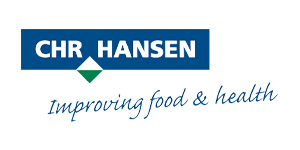- Customer Success Stories
- Chr. Hansen

A healthier planet through bioscience innovation

SAS helps prove efficacy of microbial strains to get novel probiotics to market faster.

Improved animal health and greater sustainability from farm to fork
Chr. Hansen achieved this using • SAS® Analytics
The world’s most sustainable biotech company, Chr. Hansen, uses SAS Analytics to develop effective, natural probiotics for animal health, enabling farmers to produce high-quality, safe food for global consumers
To feed a growing population, farmers need their livestock to not just survive, but thrive. But too often challenges like bad weather, disease and poor nutrition result in stressed and sick animals, requiring significant time and money to treat, and producing lower than desirable yields.
Daily feeding of effective probiotics has been proven to support the health and well-being of animals. For producers, adding probiotics to animal feed helps keep the intestinal tracts of the animals in their care in good condition, leading to a range of health benefits including the appropriate digestion and absorption of nutrients and essential barrier and immunity functions of the gut.
The use of probiotics in livestock feed is nothing new; 30 years ago, the agricultural industry knew them as direct-fed microbials. When fed to animals, these microorganisms were said to improve health in many ways.
But the big question remained: How exactly do these microorganisms exert their beneficial effect? Knowing the answer to this question could help biotech companies like Chr. Hansen improve the quality of the microbiome, thus improving animal health and the sustainable production of milk, eggs and meat.
At the center of this story is Dr. Steve Lerner, Director of Marketing and Product Management in North America for Animal Health at Chr. Hansen. With a doctorate in reproductive physiology, postdoctoral experience in molecular genetics, and stints at Carnegie Mellon and MIT, Lerner has dedicated much of his scientific life to answering this important question.
He frames it this way: “The variation in DNA between any two humans is about 0.1%. In contrast, for two strains of the same bacterium, this can be as high as 18%. So if you think about the 150 trillion organisms that live within a dairy cow, for example, and how the impact of each and every probiotic strain can differ drastically, we have a tremendous amount of curiosity about how these organisms are truly affecting the lives of the animals that are hosting them.”
According to Lerner, deducing how each potential probiotic strain manifests its effects in livestock in a credible, demonstrable and transparent way requires the use of advanced statistical analysis and powerful analytics. That’s where SAS comes into play.
We believe SAS is paramount to our success, not only to find differences in probiotic strains, but also to communicate the results to an educated scientific audience. It’s highly influential to show that we’re engaging in the proper analysis, and SAS is integral in these efforts. Dr. Steve Lerner Director of Marketing and Product Management, North America, Animal Health Chr. Hansen
Analyzing the product life cycle
Founded in 1874 and headquartered in Denmark, Chr. Hansen is a global bioscience company that develops natural ingredient solutions for the food, nutritional, pharmaceutical and agricultural industries. Every day, Chr. Hansen’s ingredients are consumed by more than 1 billion people.
With the world’s population projected to reach 10 billion by 2050, overall food demand is expected to increase by more than 50%, and demand for animal-based foods will increase by nearly 70%, according to a recent study by the World Resources Institute. Chr. Hansen’s natural solutions play a key role in creating a food system that is resilient and prepared to feed the growing population. The company’s nearly 40,000 microbial strains position it to address some of society’s most pressing challenges, such as adverse climate impact, ensuring greater sustainability from farm to fork.
When Lerner joined Chr. Hansen, SAS was already entrenched across the animal health ecosystem. He immediately got to work using SAS Analytics to evaluate the efficacy of Chr. Hansen products in animals and uncover the most effective combinations of bacteria.
With SAS, scientists like Lerner who support the innovation pipeline can analyze large volumes of variance data from Chr. Hansen’s research as well as outside sources. For dairy cattle, they look at things like conception rates and the efficiency of milk production. For pig production, it’s the efficiency of reproduction, the lactation feed intake and the weaning weight of piglets. Regarding poultry, they look at data pertaining to the efficiency of egg production or poultry meat production.
According to Lerner, SAS makes it possible to analyze this data en masse and tease out meaningful differences in the relationships between phenotypic expression and genotype.
“To find subtle differences among the thousands of strains we’re evaluating, it must go into a powerful statistical tool,” Lerner says. “And we’ve found the best solution for the job is SAS.”
Once lab work is complete for a given product, the next step is testing it in the field in animals. During these research and observational field trials, SAS enables Chr. Hansen to analyze the test results and avoid outsourcing this work to a third-party biostatistician – a common practice in the industry. By using SAS to evaluate test results, Chr. Hansen saves time and money, helping get novel probiotics into the market faster.
“SAS helps us move with confidence in our selection processes, prove the efficacy of those strains and rapidly bring new strains to the market,” says Lerner.
Chr. Hansen – Facts & Figures
1 billion
people consume products containing Chr. Hansen’s natural ingredients every day
50%
of the cheese and yogurt in the world contain Chr. Hansen’s natural ingredients
40,000
microbial strains in its collection
The most sustainable biotech company in the world
For Chr. Hansen, it’s not enough to say its probiotics are effective – the company must prove it. SAS allows Lerner and the sales, marketing and technical services teams to stand before nutritionists, veterinarians and producers – all potential customers – and demonstrate its analytical methodologies, such as how each analysis was done and how error was managed, thereby increasing acceptance of the data.
“We believe SAS is paramount to our success, not only to find differences in probiotic strains, but also to communicate the results to an educated scientific audience,” Lerner says. “It’s highly influential to show that we’re engaging in the proper analysis, and SAS is integral in these efforts.”
Likewise, SAS makes it easier for Chr. Hansen salespeople to get behind new products.
“A confident salesperson is effective,” Lerner says. “So when you can create a compelling story based on sound data and analytics in an expeditious way, the chance of that sales effort being successful goes up.”
The company’s innovative approach is working. Revenue is growing steadily, and for the third consecutive year, Chr. Hansen was named “the most sustainable biotech company in the world” by the Corporate Knights of Canada.
“When it comes to sustainability, SAS Analytics plays a vital role,” Lerner says. “Our ability to demonstrate the efficacy of our products in a convincing and transparent way improves the strength and credibility of our story when being considered for such an accolade.”
Building a sustainable future
The tie between analytics and sustainability goes beyond the ability to analyze and demonstrate a product’s effectiveness. It comes down to efficiency.
Chr. Hansen looks at every problem through an environmental lens, where production efficiency is often the focus. The company believes, for example, that if it can make animals more efficient utilizers of feed, it can reduce nitrogen waste. And if it can get more nitrogen into the milk, eggs and meat of animals, it can increase the efficiency of production of those foods.
Put another way, with its innovative analytics platform, Chr. Hansen enables farmers to produce high-quality, sustainable and safe food for global consumers.
Looking forward, Chr. Hansen plans to further the burgeoning field of metabolomics, in which the actual output products from the microbiota that populates the gut are analyzed to reveal the beneficial effects to their host. This exciting new field has the potential to unlock even more breakthroughs in probiotic health for every animal, plant and human on the planet.
“This is where the proper use of meaningful analytics is going to make a huge difference,” concludes Lerner. “And that’s exactly where SAS shines.”